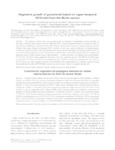Use este identificador para citar ou linkar para este item:
http://www.alice.cnptia.embrapa.br/alice/handle/doc/1058393| Título: | Vegetative growth of grasslands based on hyper-temporal NDVI data from the Modis sensor. |
| Autoria: | HOTT, M. C.  CARVALHO, L. M. T. de   ANTUNES, M. A. H.   SANTOS, P. A. dos   ARANTES, T. B.   RESENDE, J. C. de   ROCHA, W. S. D. da   |
| Afiliação: | MARCOS CICARINI HOTT, CNPGL; Luis Marcelo Tavares de Carvalho, UFLA; Mauro Antonio Homem Antunes, UFRRJ; Polyanne Aguiar dos Santos, UFLA; Tássia Borges Arantes, UFLA; JOAO CESAR DE RESENDE, CNPGL; WADSON SEBASTIAO DUARTE DA ROCHA, CNPGL. |
| Ano de publicação: | 2016 |
| Referência: | Pesquisa Agropecuária Brasileira, v. 51, n. 7, p. 858-868, 2016. |
| Conteúdo: | ABSTRACT - The objective of this work was to analyze the development of grasslands in Zona da Mata, in the state of Minas Gerais, Brazil, between 2000 and 2013, using a parameter based on the growth index of the normalized difference vegetation index (NDVI) from the moderate resolution imaging spectroradiometer (Modis) data series. Based on temporal NDVI profiles, which were used as indicators of edaphoclimatic conditions, the growth index (GI) was estimated for 16‑day periods throughout the spring season of 2012 to early 2013, being compared with the average GI from 2000 to 2011, used as the reference period. Currently, the grassland areas in Zona da Mata occupy approximately 1.2 million hectares. According to the used methods, 177,322 ha (14.61%) of these grassland areas have very low vegetative growth; 577,698 ha (45.96%) have low growth; 433,475 ha (35.72%) have balanced growth; 39,980 ha (3.29%) have high growth; and 5,032 ha (0.41%) have very high vegetative growth. The grasslands had predominantly low vegetative growth during the studied period, and the NDVI/Modis series is a useful source of data for regional assessments. RESUMO - O objetivo deste trabalho foi analisar o desenvolvimento das pastagens na Zona da Mata, em Minas Gerais, entre 2000 e 2013, com uso de um parâmetro baseado no índice de crescimento do índice de vegetação da diferença normalizada (NDVI) a partir de séries de dados do "moderate resolution imaging spectrodiometer" (Modis). A partir dos perfis temporais do NDVI, usados como indicadores das condições edafoclimáticas, estimou-se o índice de crescimento (IC) para períodos de 16 dias da estação primaveril de 2012 até o início de 2013, o qual foi comparado ao IC médio de 2000 a 2011, período usado como referência. A área atual de pastagens na Zona da Mata é de aproximadamente 1,2 milhão de hectares. De acordo com os métodos usados, 177.322 ha (14,61%) destas áreas de pastagens apresentam crescimento vegetativo muito baixo; 577.698 ha (45,96%), crescimento baixo; 433.475 ha (35,72%), crescimento equilibrado; 39.980 ha (3,29%), crescimento alto; e 5.032 ha (0,41%), crescimento vegetativo muito alto. As pastagens apresentaram baixo crescimento vegetativo durante o período estudado, e a série NDVI/Modis é fonte útil de dados para a avaliação regional. |
| NAL Thesaurus: | pastures remote sensing |
| Palavras-chave: | Growth index Time series Zona da Mata |
| Digital Object Identifier: | https://doi.org/10.1590/S0100-204X2016000700009 |
| Tipo do material: | Artigo de periódico |
| Acesso: | openAccess |
| Aparece nas coleções: | Artigo em periódico indexado (CNPGL)  |
Arquivos associados a este item:
| Arquivo | Descrição | Tamanho | Formato | |
|---|---|---|---|---|
| Cnpgl2016PABVegetative.pdf | 1,06 MB | Adobe PDF |  Visualizar/Abrir |









